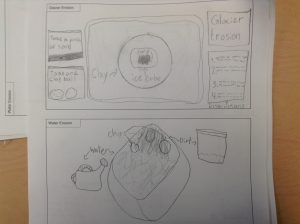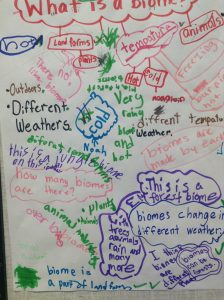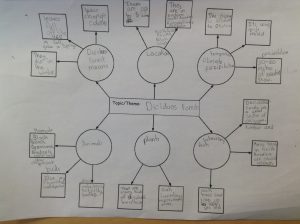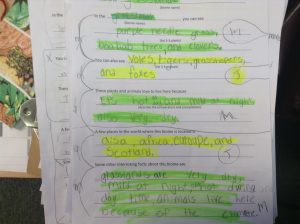Today I tried a new method for engaging all students in discussion. I have a great group of students who have a ton of ideas to share. I have noticed that sometimes, there a few quieter students who get lost in the mix because I have so many students who are willing to share and discuss. This technique involves giving each student 3 Popsicle sticks. By the end of the discussion each student must have given away one Popsicle stick. For students who have a lot of ideas to share, they can only share 3 times. This encourages quieter students to share and students with lots of ideas to think about what they are choosing to share. I found this technique worked effectively for my students. I saw students who like to share a lot stop to think about what they were going to share and make their sharing count. Some students chose to share comments that were not always on task and were disappointed when there Popsicle sticks were gone and they could not share anymore.
All students contributed to our discussion on explorers and exploration and the energy and excitement in the room was tangible. Towards the end of the discussion some students had not shared and I made sure to check in with them to see if they needed more think time. Giving these students think time allowed them to feel safe when sharing and also gave other students the opportunity to have another turn to speak. I was particularly pleased to hear some well-thought out answers from students who rarely share in a group discussion. I plan to use this strategy again because I think it is beneficial to all students. Students learn that there opinions and thoughts are valuable and add to the discussion. I hope to encourage the quieter students to share on their own as they become more comfortable voicing their opinions in front of the class. I also hope to help students who love to share think about using their Popsicle sticks to share in a meaningful way that enriches the conversation.
I found that from an assessment perspective this was a low-tech way to quickly check in with my students on their understanding of the topic. I was able to tell who was following the conversation and understood the questions. Once everyone had shared I felt confident that all students understood what an explorer is.
At the end I still had 6-7 students who wanted to share and still had Popsicle sticks left. There was not enough time to have all students share in a big group and I felt that our class discussion and yielded a rich variety of answers. I had my students quickly pair up and share their remaining thoughts on the topic with a partner. I was then able to engage with a few students close to me who had questions or who had a thought they wanted to share with me.













